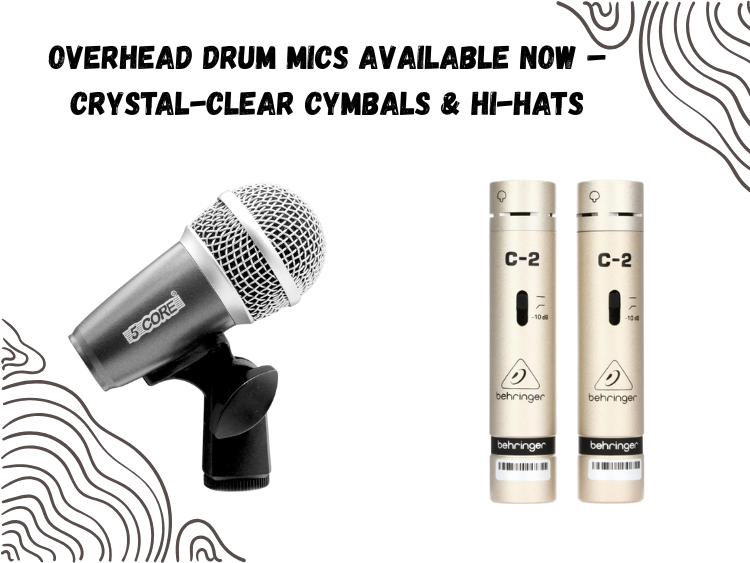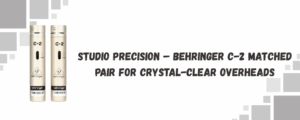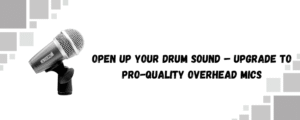In a live gig or a studio session, overhead drum mics do the heavy lifting when it comes to capturing cymbals, hi-hats, and the full stereo image of a drum kit. They’re not just accessories—they define the texture, openness, and clarity of your drum sound. If your cymbals sound washy or your hi-hats lack detail, the issue usually points to subpar overheads.
And if you’ve been stuck with budget condenser mics that barely keep up, it’s time to change that. Whether you’re building your first rig or upgrading your old kit, here’s what you need to know before buying overhead drum mics—and which models are worth adding to cart.
Why Overheads Are the Backbone of Drum Clarity
Overheads don’t just pick up cymbals—they help tie the entire drum kit together. Kick and snare mics capture power. Toms bring body. But overheads? They deliver the sparkle, air, and spatial feel that makes the whole kit sound cohesive.
In a basic setup, especially for home studios or small venues, a solid pair of overheads can carry most of the load. Engineers often refer to this as a “Glyn Johns”-style approach—two mics positioned to get the kit’s full image. It works, and it works well, if your mics are up to the task.
What to Look for in Overhead Drum Mics
A good overhead mic must meet three non-negotiables:
- Wide frequency response – especially in the 5kHz–15kHz range where cymbals live.
- Matched pair accuracy – both mics must respond consistently to avoid phasing issues.
- Low self-noise – the quieter the mic, the better it performs in dynamic environments.
If you’re using dynamics as overheads, you’re compromising. While they can handle higher SPL, they don’t catch the subtle shimmer that makes hi-hats cut or crashes sparkle.
Condenser mics, especially small-diaphragm ones, are the real deal here. They offer detail, speed, and accuracy that no dynamic mic can match.
5 Core’s 7-Piece Drum Mic Kit – A Surprising Overhead Solution
For drummers on a budget who still want professional-level performance, the 5 Core 7-Piece Drum Mic Kit is a smart entry point.
You get full coverage—kick, snare, toms—and yes, overheads too. The included pencil-style condensers are designed for capturing cymbals and hi-hats with balance and clarity. They aren’t boutique-priced, but they punch far above their weight.
What stands out: the mics are rugged, the build is all-metal, and the set ships with holders and a carry case. It’s plug-and-play for home studios, content creators, or drummers tired of renting gear for rehearsals.
You’re not just getting throw-in overheads. These condenser mics hold their own in a stereo XY or spaced pair configuration, making them versatile for both drum tracking and ambient room capture.
For Studio Purists: The Behringer C-2 Matched Pair
For those wanting a pure, no-frills stereo pair strictly for overheads, the Behringer C-2 matched pair remains one of the most consistent options in the entry-level market.
Engineered specifically for applications like cymbals, hi-hats, and room recordings, these small diaphragm condensers come matched from the factory—so you don’t run into stereo image issues out of the box.
And despite their price, they aren’t thin-sounding. They capture the sizzle and decay of crash cymbals with more detail than many models twice their price.
They’re not made to survive drops or harsh live environments. But in a controlled studio setting, paired with a clean preamp and good mic placement, they just work.
Why Placement Still Matters (Even with Good Mics)
You could drop a grand on boutique condensers, and they’d still sound off if your placement sucks. Overheads aren’t “just put them up and go.”
For a wide stereo image, spaced pair (one over each side of the kit) is the classic approach. It opens up cymbals and gives you a bigger room feel.
If phase alignment is your priority, XY or ORTF configurations are better. These minimize time delay between capsules, which keeps things tight and focused—especially great for tighter mixes or smaller rooms.
In either case, height and angle matter more than most assume. Too close, and you’ll get harsh cymbals. Too far, and you lose detail.
The Smart Move: Bundle or Pair?
If you already have a snare and kick setup dialed in, a dedicated stereo pair like the C-2 makes more sense. But if you’re building from scratch or replacing an outdated kit, something like the 5 Core 7-piece set saves time and money without sacrificing clarity.
Plus, having extra mics never hurts. A second pair of overheads can double as ambient room mics or even be repurposed for acoustic guitars or percussion.
Final Word: Don’t Skimp on Overheads
Overhead drum mics aren’t optional—they’re foundational. They catch the shimmer, the bleed, the energy of your performance. Skimp here, and your recordings or live sound will always feel flat, no matter how good your snare or kick sounds.
Whether you go for a versatile all-in-one kit like 5 Core’s DM-7RND-BLK or opt for the clean precision of the Behringer C-2 pair, the goal is the same—clear, punchy, natural cymbal and hi-hat sound that translates in every mix.
If your overheads are holding you back, now’s the time to fix it.




